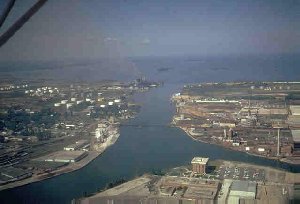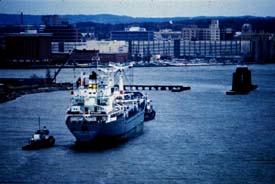Harbor And Marina Issues

In August, 1997, Clean Water Action Council of Northeast Wisconsin finally won our legal battle to stop the tripling expansion of Renard Island. For decades, 2.7 million cubic feet of Green Bay harbor dredging, containing toxic PCBs, were dumped on Renard Island, formerly known as Kidney Island, offshore from Bay Beach Amusement Park in Green Bay, Wisconsin. We showed that citizens could successfully challenge the U.S. Army Corps of Engineers (USACE), Brown County Harbor Commission, and the Wisconsin Dept. of Natural Resources (WDNR).
This artificial island was first created in 1976 as a disposal site for PCB-contaminated sediments dredged from the seven mile shipping channel for Brown County's Harbor at the mouth of the Fox River, in the City of Green Bay.
13 Year Struggle to Stop Renard Island Expansion
The battle began in 1984 with the release of the USACE’s Environmental Impact Statement for the expansion of the island from 55 to 186 acres, which was criticized as grossly inadequate by many natural resource agencies (including WDNR, U.S. Environmental Protection Agency (EPA), and U.S. Fish and Wildlife Service).
For a few years, as the USACE applied for permits, it seemed WDNR was certain to deny the project, but the political winds changed, Gov. Thompson was elected in the fall of 1986, and WDNR caved in.
After 13 years, the project supporters were still proposing the same old island design, and still could not answer basic questions about a final land-use plan for the island, long-term care costs, contingency plans in the event of major storms, how they intended to monitor for leakage, or what they would do if leakage was detected.
The WDNR's wastewater discharge permit for the island proposed to allow the expansion and then see if it could meet permit limits, because WDNR was not at all sure the island could meet state standards. We were not allowed to challenge the solid waste permit, or the wastewater discharge permit, but we did challenge the Water Quality Certification permit, and this was enough.
Judge Agreed Water Quality Could Be Threatened
Judge Jeffrey Boldt confirmed that the project supporters couldn't prove that water quality would be protected to state standards if the island were tripled in size. The oxygen levels in the water could drop below healthy levels --- because the expansion would block the river currents flowing into the bay, creating pockets of stagnation along the East Shore.
Second Win
This is the same case that citizens had already won, through the leadership and hard work of attorney Thomas Dawson, former Wisconsin Public Intervener, back in 1988. In court, during cross-examination, Dawson exposed an effort by several high-level WDNR staff to knowingly use faulty calculations to claim the island was safe.
The WDNR reissued the same Renard Island expansion permit in 1995, just a few weeks after the Wisconsin Public Intervener Office was closed by Republican legislators and Gov. Tommy Thompson. Again, the WDNR used the same key staff person to issue the new permit and to testify in court as an “expert." The judge wouldn't allow us to challenge his trustworthiness during the trial, but the judge's final decision was critical of the agency's actions.
Wasted Money and Time
This case provides another example of the USACE’s wasteful habits and mismanagement. It's rumored that the USACE spent more than $1 million developing the new, highly complex computer model and extensive reports on water currents and chemistry around the island, but they refused to calibrate and verify the model with real-life data from the Bay.
Our expert, Dr. Kwang Lee, an engineering professor with UW-Milwaukee, said the model was much more complex than necessary and the Corps should have focused more on actual water quality and current measurements. The data which did exist showed the bay was already having dissolved-oxygen problems and the island could make it worse, and there also was clear photographic evidence showing that the island is causing toxic sediment buildup between the island and Bay Beach Amusement Park.
Brown County and USACE Blame Environmentalists
Following the judge's decision, Brown County and the USACE tried to make the public think that just a small group of extremist environmentalists blocked a wonderful and essential project, and this would cost Brown County taxpayers dearly. It's odd how they can turn an issue on its head.
We proved in court twice that three government agencies can't be trusted to abide by the law and protect water quality --- yet they made it seem the fault of "environmentalists." They ignored the thousands of petition signatures, letters, yard signs, and testimony from ordinary local citizens who could never be described as radicals.
Costly Stubborness
The truth is that the inflexibility of these government agencies led to high costs and years of delay. Local citizens and the Public Intervener Office urged the USACE and Brown County to look for alternatives, but it seemed that pure stubbornness and pride kept them locked into only this project at all costs.
The Corps never seriously tried to move the $20 million in federal funds from the island expansion to any other alternative project. They simply dug in their heels and refused to budge for 13 years. If this means that Brown County taxpayers will have to pay more for harbor maintenance, the USACE and Brown County are responsible, not "environmentalists."
Our Congressional representatives should demand an investigation of the USACE’s behavior. County voters should demand a hard look at the Brown County Harbor Commission’s actions.
It's a Mistake to Ignore Citizen Concerns
In addition, the agencies refused to hold public hearings to allow citizens to express their strong opposition. Years of effort and millions of dollars could have been saved, if the agencies had simply been more open to public discussion and more responsive to local voters.
Unfortunately, they are continuing bad behavior patterns with the creation of a "Citizen Advisory Committee" to oversee the final closure and land use at the existing Renard Island. County officials have stacked the committee with like-minded people. Such committees are no substitute for a public hearing and true community outreach efforts. The County could easily spend much more money and time on a proposed land-use plan for the existing island, only to be shocked later to discover that this "Citizen Advisory Committee" did NOT represent the full range of strong concerns in the community.
Polluters Should Pay
Another annoying aspect of the County and USACE claims is that they're essentially blaming "environmentalists" (ie: local citizens) for the high cost of sediment disposal for maintaining the harbor.
First, they claim taxpayers will have to pick up the costs because the Federal dollars won't be as available, but the Federal dollars are our tax dollars too. This is like taking money out of one pocket to compensate the other pocket of the same pants.
Second, they keep ignoring the fact that "environmentalists" are not responsible for causing the sediment disposal problem. The polluting industries along the Fox River are responsible. The polluters should be paying every penny required to clean-up the harbor sediments. Taxpayers should not get stuck with this unfair cost. In fact, Brown County and federal taxpayers should be reimbursed for all the extra costs they've already experienced over the past 30 years due to the
Third, County officials have been unwilling to conduct a comprehensive cost-benefit analysis to determine whether it makes sense to continue maintaining this port at current operation levels.
If industries like Fort Howard Corporation (now Georgia-Pacific Corporation) are so dependent on this harbor for their survival, let them pay for cleaning up the toxic chemicals they dumped, which have damaged their harbor.
Corps Data Unreliable
An interesting sidelight of a recent public presentation by Fox River clean-up parties, were some extremely blunt comments made by a WDNR sediment expert concerning the USACE’s chemical analysis of harbor sediments. The USACE and County have been claiming recently that environmentalists are exaggerating the toxic dangers of the channel dredging’s. The USACE claims sediments are much cleaner now, yet the WDNR's expert on sediment announced that the USACE data was highly questionable and unreliable.
It's unfortunate the WDNR did not say this during our Renard Island trial --- the WDNR attorney was too busy defending the USACE against citizens. But at least this reinforces our arguments about the need for better scrutiny of USACEs’ projects and careful handling of the sediments.
Bay is Already Oxygen Depleted

Our legal case challenging Renard Island highlighted another concern. The lower Bay of Green Bay is already suffering from repeated bouts of low oxygen in the water, according to research data presented during our trial. Oxygen sags can result in fish kills and other unpleasant water conditions.
This raises serious questions about the way the WDNR issues pollution permits on the Fox River. The WDNR assigns industries "rights to pollute" (called Wasteload Allocations) and argues that the river can handle a certain level of pollution without violating state standards, because the flowing water carries pollution "away."
However, the WDNR ignores the fact that this pollution ends up in Green Bay, which has far less circulation to stir oxygen into the water, and that Lake Michigan flushes through only once every 99 years or so. Essentially, it's a closed system. The pollution isn't going anywhere. DNR must re-think its permits to better restrict dumping of wastes which deplete dissolved oxygen. Land run-off from streets, construction sites and farmland also need better controls if we hope to solve this oxygen loss.
It's Not Really Over
Even though we won this case and stopped the expansion, we still need to keep an eye on the existing Renard Island. A 55-acre toxic island is already there and many questions are still unanswered:
1. Leakage Repair --- Now that the expansion plans are over, the USACE plans to "finish" the island and turn it over to Brown County for long-term care at local taxpayer expense. Before this happens, the USACE should be required to seal the leaks in the island, otherwise the County could be liable for expensive repairs later. The USACE has acknowledged now that the island was designed to leak. The walls are simply interlocking sheet-metal pilings held up with large rip-rap rocks. A gap was deliberately left along the bottoms of the wall to allow the island to be dewatered as it filled. As wet sludge is piled on top, the water squeezes out the bottom, carrying toxic contaminants with it into the Bay. For years, the Corps tried to tell us all the drainage water went through filter structures built at one end of the island, but their deliberate lie has been exposed.
A dye-tracer study has never been done to document leakage from Renard Island, but dye-tracer studies at four similar islands built by the USACE at Wisconsin harbors along Lake Michigan showed extensive leakage, with up to 90% of the water flowing directly through the walls into the Lake. They leaked like sieves. Repairs were required at those other sites, but nothing has been done in Green Bay.
If the expansion required a pollution discharge permit and was required to meet Wisconsin's water quality standards, then the existing island should be required to meet those standards as well. This is the USACE’s responsibility and they should not be allowed to avoid it. They might argue that the existing island pre-dates Wisconsin's standards, but none of the other old existing industrial or municipal pollution sources are exempt.
All this concern about sediment leakage may seem silly now; after all, the sediment came from the bay, so what difference does it make if some escapes back into the bay? However, we need to think about the future. Hundreds of millions of dollars may be spent to clean up the Fox River and Bay. In 20 years, the water could be much cleaner, but if the island breaks apart this could ruin the Bay clean-up effort, and fish and wildlife could be affected again until the system finally buries or disperses the toxic chemicals.
2. Contingency Plans --- Brown County still lacks a clear plan on how much money county taxpayers will be asked to set aside for regular maintenance and storm damage of the island. Though the County is responsible, they seem determined to rely on the USACE. After a major storm or accident, it is possible the island could be spilling its toxic contents into the bay while the agencies wrangle over who is responsible.
3. Surface Land Use --- The existing island has become a major nesting site for colonial nesting birds, including some rare species of Terns. Many human recreational uses have been proposed. Green Bay Mayor Jim Schmitt stated in 2010 that this is a piece of property the city wants to get its hands on for future development of Bay Beach Amusement Park. However, before any development could occur, a safe cap would need to be placed over the contaminated dredging. The USACE is planning capping for the winter of 2013-2014, but proposes to use sediments previously dredged and stored in Cell 7 of the Bayport facility. Those sediments were dredged from areas of the outer bay. Hearings should be held to take public comment on this USACE capping plan.
Future Harbor & Marina Dredgings
CWAC maintains that areas for proposed dredging need to be tested for PCB content and the EPA guidelines should be followed for placement of contaminated sediments. Use of PCB-contaminated dredging should not be allowed for use in road construction as industry interests have suggested.

